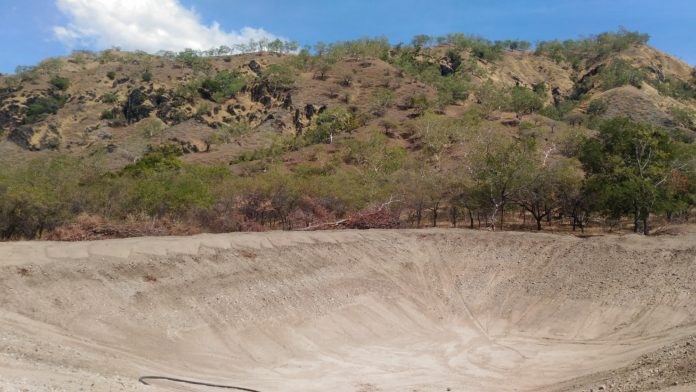
The latest condition of Embung construction in Humusu Wini Village, Timor Tengah Utara Municipal (NTT). Photo by Reynaldo D.R. Sondi
Embung is a basin designed to contain waters. The function of Embung is similar to the function of a reservoir or a dam. Things that disseminates Embung and dam are just the capacity of containment and coverage area of the Embung. Embung has much smaller capacity than a dam.
In terms of the small amount of storage capacity. The usage of water that is contained by the Embung is not as large as dam. Water contained in an Embung is usually allocated for rice fields irrigation. In the other hand, Embung also can be used for public open-space.
One example is Embung Tambak Boyo in Yogyakarta. This embung is usually used by the community to exercise in the afternoon. Source of water in the Embung comes from the rivers or rainfall. Embung can be built in a location that has no rivers around.
In the era of President Jokowi-Jusuf Kalla, embung is one of priority program of the government. Recently the government is intensifying the construction of embung to boost the national food production.
The village of Humusu Wini, Insana Utara Subdistrict, Timor Tengah Utara Municipal, is not having an embung. Even though the construction of Embung has been planned since 2010, the development of the contruction is relatively stagnant. Embung in Humusu Wini is located in Tubu. Recently, the condition of this embung is just in digging phase. Since the beginning of 2018, there is no further development in the embung.
Food Security
One of the priority of the government is “Building Indonesia from the Borders by Strengthening Subdistricts and Villages in the Framework of Unitary State”. That priority is stated in National Mid-term Development Plan (RPJMN) 2015-2019 Chapter VI about National Development Agenda. If we switch for a while to Priority Job Plant (RKP) of the government in 2018, food security was the priority of the government. Seeing those facts, it can be inferred the lines between those two sectors.
Let’s take a look for a while to the agriculture condition in Humusu Wini. Almost there is no full time in these border village. Usually, the farmers just work on the rice fields in the rainy seasons, while the rice fields is empty in dry seasons.
In dry seasons, most of the farmers switch their profession into fishermen or Asam farmer.
It has been a common scenery to see a yellow and dry rice fields along the road in the village. Moreover, Humusu Wini includes in one of the village that has a difficulty to get access to water, and rarely rain. This village on has 10mm/year of rainfall (BPS, 2016). In dry seasons, most of the farmers switch their profession into fishermen or Asam farmer.
Keep in mind that Asam tree can grow well in dry seasons, most of the farmers make this choice as the last option to earn a living. Of course, it is not so good for the economy and food security in Humusu Wini.
According to Center of Statistics Board (BPS) in Timor Tengah Utara (TTU) Municipal, in 2015, rice productivity in TTU is 2708 tons/hectare. Insana Utara subdistrict has a rice field as wide as 580 hectare (BPS, 2016). It means that 1570.64 tons of rice can be produced each year. However, it is still relatively low.
If there is embung support in the villages in Insana Utara Subdistrict, of course this amount can increase. Because the water from the embung can be flowed into the fields, so that the fields can be irrigated all the time. Thus there will be no more sight of empty rice fields during the dry season.
Later with the embung, of course residents and the local government can design an irrigation channel that can irrigate all fields in Humusu Wini Village. If that is realized, it will certainly help the farmers of the village. The presence of embung that will store rain water will certainly create irrigation channels that drain water into the fields so farmers can work on the land throughout the year.
In the long term, rice cultivation of two to three in a year can be realized. With the increase in rice production, of course this can support the food security of Humusu Wini Village, and support the village economy from the agricultural sector.
(Author: Reynaldo Daniel Ruma Sondi ; Source: https://muda.kompas.id/2018/08/06/embung-kunci-pertanian-berkelanjutan-humusu-wini/; translator: Harun Ardiansyah)
